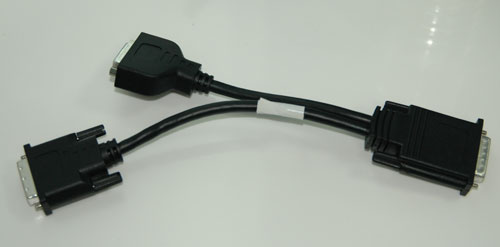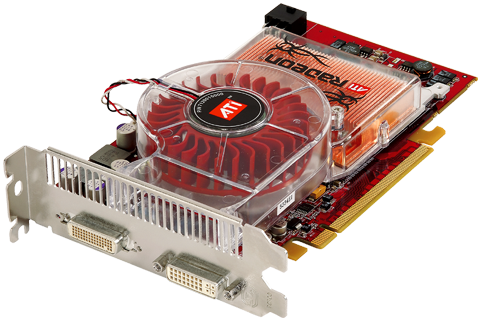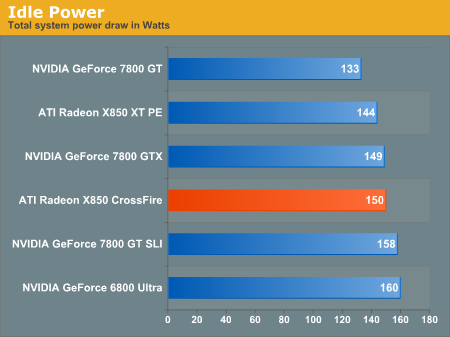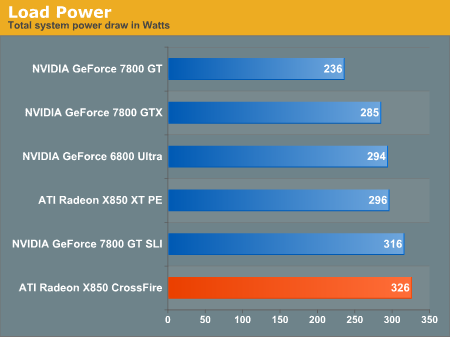ATI's X8xx CrossFire Graphics Arrive
by Derek Wilson on September 26, 2005 1:00 PM EST- Posted in
- GPUs
Hardware and Power
The components that go into a CrossFire system consist of the CrossFire master card, a slave card, a CrossFire dongle, and a motherboard with more than 1 PCI Express x16 slot. Here's the run down of our test system:AMD Athlon 64 FX-55
ATI Radeon Xpress 200 CrossFire motherboard
1GB DDR400 2:2:2:8 RAM
120GB Seagate 7200.7 HD
OCZ Powerstream 600W PSU
The CrossFire master card is basically an X850 XT with the addition of a Xilinx FPGA (for the compositing engine) and a TMDS receiver for taking input from the slave card. Instead of 2 DVI-D ports, the CrossFire master card makes use of a high speed DMS port. This connects to one port of the CrossFire dongle and takes the slave card input as well as providing the output to the monitor.

Other than that, the CrossFire card looks just like any other X850 XT out there.

The CrossFire design is fundamentally different than NVIDIA's SLI. CrossFire uses an external compositing engine while NVIDIA's is built into the GPU. ATI handles communication via TMDS output from the slave card's framebuffer, while NVIDIA built a chip to chip communications protocol for multi-GPU operation. Both vendors offer extended antialiasing modes, but ATI offers an additional rendering mode called SuperTiling which cuts each scene up into a checkerboard pattern for rendering.
On both solutions, Alternate Frame Rendering (AFR) is the fastest mode, as this is the only mode that also accelerates geometry processing. In order to learn more about the details of how CrossFire works, please check out our previous article on the subject.
As for the stress all this hardware puts on a system when it's in action, here's a comparisons of idle and load power (under Splinter Cell: Chaos Theory). Power is measured at the wall before the PSU.


While the idle power draw is slightly lower than 7800 GT SLI, the load power is the highest of any of the measured setups. 7800 GTX SLI would be higher still, but X850 XT PE Crossfire is really closer to the 6800 Ultra SLI or 7800 GT SLI, so it's not a fair comparison. We'll have to wait for R5xx and Crossfire before we can get a good idea of how Crossfire competes with 7800 GTX SLI.










76 Comments
View All Comments
erinlegault - Tuesday, September 27, 2005 - link
Well because the 1600x1200@60Hz is only a limitation because of the existing x800 family of cards and not the x850 family and definately not Crossfire itself.
Pete - Wednesday, September 28, 2005 - link
It's a limitation of the X8xx esries, as they all feature single-link TDMS transmitters, and so the Master cards have single-link TDMS receivers. They should be good for more than 16x12@72Hz, per DVI spec; hopefully future drivers will up this a bit.Plus, didn't The Inq show a pic of 19x12@52Hz?
vijay333 - Monday, September 26, 2005 - link
Valid points, don't see why some people are ranking this post down.Pete - Monday, September 26, 2005 - link
I really like how concise and readable the first few pages are.I do agree that comparing XF directly to the "2nd gen" SLI of the 7800 is a little unfair, but it's still potentially useful to some people, and you obviously left in XF's direct competitors, 6800 SLI and a single 7800. This does take the article in the 'too much info' direction, as opposed to the first few pages' 'just enough' method.
I have a few suggestions and corrections, if you don't mind.
* Perhaps you could elaborate on how XF will remove the res/refresh limitation with the R520 line-ups dual-link TDMS transmitters? This is appropriate in terms of the 7800 SLI comparison, although who knows when X1800 XF will show up.
* On that note, I've read elsewhere that SuperAA is so unbelievably slow because XF is actually using PCIe (bandwidth- and latency-limited) lanes and then the "master" GPU (for inter-GPU communication and then to composite the image, respectively), and not the dongle and CE (as with "normal" XF operation). This will supposedly be corrected in a future driver, but (IMO) it's as big a shortcoming (however temporary) as the (permanent, hardware-imposed) resolution limit. And I'm quite skeptical about future driver fixes, though it seems essential that ATI solve this one.
* p.6, you write "pre" instead of "per."
* p.7, "worth" instead of "worthy."
Will you be examining these issues at Ibiza, or will you have time before packing your sunscreen? :D
(And no, I'm not ignoring you, I'm just an incredibly slow and unimaginative thinker at times.)
DerekWilson - Monday, September 26, 2005 - link
I did mention that ATI's next gen part should remove the limitations of the single-link TMDS somewhere in there ... I am unable to go into detail at this time.I'll have to follow up on the PCIe rather than TMDS angle. That would make some sense to me though. All the subsamples from a single pixel may need to be in the same framebuffer in order for ATI to perform proper AA on them. It may be that the gamma adjustment causes some problems with doing a straight blend between the two scenes. Of course, that's speculation about speculation, so I wouldn't put much stock in my musings :-) As I said though, I'll follow up on this.
I fixed my typos. Thanks.
Glad you liked the article. And where I'm going next sunscreen won't be of much use. :-(
Also, I didn't think you were ignoring me. I've actually been pretty busy myself lately, so I completely understand.
tfranzese - Monday, September 26, 2005 - link
I'd appreciate it if all graphs had units attached. Numbers are certainly not good if they don't have units attached.OvErHeAtInG - Monday, September 26, 2005 - link
Is it the mode scaling you're worried about?From p 6: "Our graphs show frames per second on the y-axis and AA mode across the x-axis."
The rest of the sideways-historam-thingies show fps. That is pretty standard.
OvErHeAtInG - Monday, September 26, 2005 - link
I meant histogram, not historam. D'oh! And yes, I realize it's not really a histogram. Bar chart ? Ah! Who cares.OvErHeAtInG - Monday, September 26, 2005 - link
Or watts for the wattage graphs. :)Stefan - Monday, September 26, 2005 - link
Shouldn't we be comparing the Crossfire to the 6800 Ultra SLI and not the 7800 GTX SLI?I thought ATi's new X1800 Crossfire was going to be the 7800's counter. Or am I mistaken?